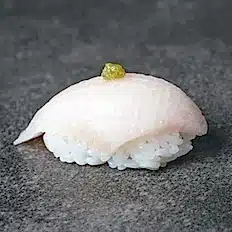Hamachi Sushi (Yellowtail) - The Buttery Jewel You Must Try Today
Hamachi Sushi is Truly A Gift From The Sea
 If you’re a sushi enthusiast, you’ve probably come across hamachi, even if you didn’t realize it. Known for its rich, buttery flavor and smooth texture, hamachi is a sushi bar favorite that often sits next to better-known offerings like maguro (tuna) or sake (salmon). However, hamachi deserves just as much attention.
If you’re a sushi enthusiast, you’ve probably come across hamachi, even if you didn’t realize it. Known for its rich, buttery flavor and smooth texture, hamachi is a sushi bar favorite that often sits next to better-known offerings like maguro (tuna) or sake (salmon). However, hamachi deserves just as much attention.
Let’s dive into into what makes hamachi (yellowtail sushi) so special. We’ll explore its origins, its taste, how it’s served, its health benefits, and sustainability. So whether you’re new to sushi or a seasoned sushi lover, this article will show you why hamachi absolutely deserves a place on your sushi plate.
What Is Hamachi?
Hamachi, often referred to as yellowtail in English, is a sushi ingredient that comes from a young version of the Japanese amberjack (Seriola quinqueradiata). When you order hamachi at a sushi restaurant, you’re typically getting a farm-raised yellowtail, predominantly sourced from Japan, the largest supplier in the world.
Interestingly, the name of the fish changes depending on its age and size. In sushi culture, an older yellowtail is referred to as buri. While this can be confusing, the important takeaway is that hamachi refers to the younger, tender fish, which boasts a soft, delicate texture that pairs perfectly with vinegared rice.
To make it even more clear: hamachi is younger, more tender, evenly marbled with fat, and perfect for sushi, while buri represents a more mature fish that’s often enjoyed grilled or cooked in other ways. So, next time you see hamachi on a menu, know you’re getting a younger and milder version of the flavorful yellowtail. and unless you specify “buri,” you will be getting the younger, more delicate and impressive version.
Why Do People Love Yellowtail?
Hamachi is renowned for its rich, buttery texture and slightly sweet taste. Unlike some sushi types that have strong, briny, or “fishy” flavors, hamachi offers a more subtle and luxurious profile. Here’s what makes it stand out:
- Buttery Texture: The soft, almost melt-in-your-mouth texture of yellowtail is unlike many other types of fish. This buttery smoothness makes it an easy favorite among sushi lovers.
- Mild Flavor: While fish like mackerel are known for their bold, fishy taste, hamachi provides a milder experience. It’s flavorful enough to hold its own against soy sauce and wasabi, but it doesn’t overwhelm the palate.
- Versatility: Whether served as nigiri, sashimi, or in a roll, hamachi offers versatility. It pairs well with many different ingredients, enhancing its overall appeal.
For those new to sushi, hamachi is often a great introduction. Its approachable yet complex flavor is a surefire way to convert anyone into a sushi lover.
Is Yellowtail Sushi Healthy?
Hamachi is not just a tasty option but a nutritious one, too. Like many types of fatty fish, hamachi is packed with omega-3 fatty acids, high-quality protein, and essential vitamins. Here’s why it’s a great choice for health-conscious sushi fans:
- Omega-3 Fatty Acids: These healthy fats are well-known for their benefits to heart health, brain function, and reducing inflammation. Incorporating omega-3s into your diet can also lower your risk of chronic diseases.
- High in Protein: A serving of hamachi provides a substantial amount of protein, essential for muscle building and overall body repair.
- Rich in Vitamins B12 and D: These vitamins support energy production and immune function. Vitamin D, in particular, is vital for bone health.
However, it’s important to note that hamachi is also higher in fat and calories than leaner fish like tuna. While the rich fat content is part of its allure, enjoying hamachi in moderation is key,especially if you’re watching your calorie intake.
How Is Hamachi Typically Served?
At sushi restaurants, hamachi can be served in several delicious ways, each offering a unique tasting experience. Here are the most common forms:
- Hamachi Nigiri: This is the traditional way to enjoy hamachi. A thin slice of fish is placed atop a bed of vinegared rice, often with a touch of wasabi between the fish and rice. The fish’s buttery texture is complemented by the slight tang of the rice, making for a balanced bite.
- Hamachi Sashimi: If you prefer to enjoy hamachi in its purest form, sashimi is the way to go. Without the rice, you can focus entirely on the texture and flavor of the fish. It’s a delicate and refreshing option for those who love raw fish.
- Hamachi Maki: Sometimes, hamachi is included in sushi rolls (maki), often paired with ingredients like scallions or avocado. These ingredients enhance its creamy richness, creating a harmonious flavor profile. In fact, “yellowtail with scallion” is one of the most common rolls ordered, in which little slices of scallion, are added to the fish before it is rolfed. It is very simple and incredible flavorful.
- Hamachi Kama: For true sushi enthusiasts, hamachi kama, the collar of the yellowtail. is a hidden gem. This fatty, flavorful part of the fish is often grilled to perfection, delivering a smoky, tender bite that’s highly prized in Japanese cuisine.
- Hamachi Carpaccio: This is a modern twist on traditional sushi. Thin slices of hamachi are dressed with a zesty sauce, often citrus-based, and garnished with herbs or truffle oil. The combination of bright, acidic flavors and the fish’s richness makes this dish a delight.
No matter how it’s served, hamachi consistently stands out for its versatility and ability to pair well with a variety of ingredients.
The Different Cuts of Yellowtail As The Fat Content Varies

On the other hand, leaner cuts from the back (sekami) are firmer and have a more subtle taste, offering a clean, lighter bite that appeals to those who prefer less richness. Sushi aficionados often seek out these different cuts to experience the full spectrum of hamachi’s flavor profile, from the delicate lean sections to the indulgent, fatty pieces.
By understanding the diversity in fat content, you can better appreciate the art of sushi and tailor your hamachi experience to your personal taste.
Where Does This Fish Come From?
Though hamachi is closely associated with Japanese sushi, the yellowtail fish itself is found throughout the Pacific Ocean. Most of the hamachi you find in sushi restaurants today is farm-raised in Japan, where the fish are raised in controlled environments, such as sea pens.
Japanese aquaculture has refined the process of farming yellowtail, ensuring high quality and sustainability. Farmers manage the fish’s diet and health meticulously, producing hamachi that has a consistently rich flavor and firm texture—perfect for sushi.
Concerns About Hamachi Being Sustainable?
As sustainability becomes a growing concern in the seafood industry, hamachi offers a relatively sustainable option. Here’s why:
- Farm-Raised Practices: Much of the fish found in sushi restaurants is farm-raised in Japan under strict regulations. This reduces pressure on wild fish populations while ensuring a steady supply of high-quality fish.
- Environmentally Controlled Farms: By raising them in sea pens, farmers can monitor the fish’s environment and health more closely, reducing the risk of over-fishing and environmental harm.
However, it’s always a good idea to ask your sushi restaurant where their fish is sourced. Some fisheries may have different practices, so being informed helps you make sustainable choices.
How to Best Enjoy Hamachi
To fully appreciate hamachi, it’s essential to know how to get the most out of its rich flavor and texture. Here are a few tips for enhancing your hamachi experience:
- Pair with Citrus: Sometimes hamachi is served with a touch of lemon or yuzu, which adds a refreshing counterpoint to its buttery texture.
- Use Wasabi Sparingly: While hamachi pairs beautifully with wasabi, too much can overpower the fish’s delicate flavors. A small dab will elevate the experience without overwhelming your palate.
- Savor Slowly: Hamachi’s rich, creamy texture and mild sweetness are best enjoyed slowly. Take your time with each bite to fully appreciate the layers of flavor.
Interesting Facts About Hamachi
- Is Hamachi the Same as Yellowtail? Yes, hamachi is what the young of the Japanese yellowtail fish is called, and is caught when very young in the wild and farm-raised for sushi.
- What Does Hamachi Taste Like? Hamachi has a rich, buttery flavor with a smooth texture. It’s mild compared to stronger fish like mackerel, and lacks any “fishiness” flavor..
- Is Hamachi High in Mercury? Like most large fish, hamachi can contain moderate levels of mercury, so it’s best enjoyed in moderation, especially for pregnant women or children. Though the younger the fish, the less will bioaccumulate.
- Is Hamachi Healthy? Absolutely! It’s high in omega-3s, protein, and essential vitamins, making it a nutritious choice for sushi lovers.
- Can Hamachi Be Eaten Raw? Yes, hamachi is often served raw in sushi and sashimi. Its rich flavor and creamy texture make it ideal for raw preparations.
- What’s the Difference Between Hamachi and Buri? Both are yellowtail, but hamachi is the younger, more tender fish, while buri is the name for the mature version.
Why Hamachi Deserves a Spot on Your Sushi Plate
Hamachi is one of those sushi items that might not grab your attention immediately, but once you try it, it’s hard to forget. Its buttery, melt-in-your-mouth texture and mild yet rich flavor make it a standout on any sushi platter.
Whether you’re a seasoned sushi enthusiast or a newcomer looking to expand your palate, it is definitely worth a try as its unique texture and mild yet complex flavor make it a standout option for both seasoned sushi fans and newcomers alike. The next time you’re at your favorite sushi spot, don’t overlook this silky slice of heaven. Trust me, it’s an experience your taste buds won’t soon forget.
I have always been fascinated by the creation and culture of different foods, particularly sushi and sashimi in the modern era of Japanese cuisine. I am a classically trained chef and sushi connoisseur, also having operated a food service company and enjoy investigating and experimenting with food around the world.